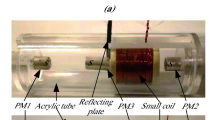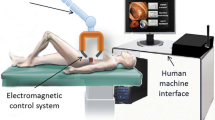Abstract
A drive and control method is put forward for a variable diameter capsule micro robot to screw forward in intestine using magnetic coupling between an inner actuator inside the robot and the rotational magnetic field generated by a rotating outer actuator. The structures of the outer and inner actuators are magnet cylinders with multiple magnetic poles in tegular shape alternating with dissimilar radial magnetization. An universal mathematical model of magnetic torque at eccentric state is established based on the equivalent magnetic charge method, and the characteristics of magnetic torque with respect to structural parameters of actuators are theoretically studied. Experiments show that the driving method features advantages such as powerful magnetic torque, high safety, reliability, etc. The driving ability of the variable diameter capsule micro robot is greatly improved by its automatic radial clearance compensation. The magnetic drive system has a promising prospect of medical applications in intestine.
Similar content being viewed by others
References
Arkady G, Harold J, Alexandra L, et al. Wireless capsule endoscopy. Isr Med Assoc J. 2002, 4(9): 717–719
Wang W. A study on RF based on wireless capsule endoscope. In: Proceedings of ICMA, Luoyang: IEEE, 2006. 1663–1667
Fu G Q, Mei T, Kong D Y, et al. Design of the image acquisition and wireless transmission branch system of wireless micro robotic endoscope system. Opt Precision Eng, 2002, 10(6): 614–618
Sendoh M, Ishiyama K, Arai K I. Direction and individual control of magnetic micromachine. J Magn Magn Mater. 2002, 38(5): 3356–3358
Sendoh M, Suda Y, Ishiyama K, et al. Fabrication of magnetic actuator for use in colon endoscope. In: Proceedings of MHS2003, Nagoya: IEEE, 2003. 165–170
Zhang Y S, Zhang K, Zhang L Y. Spiral drive characteristics of a micro robot inside human body. Rob, 2006, 28(6): 560–570
Choi H S, Lee S H, Park Il H. General formulation of equivalent magnetic charge method for force density distribution on interface of different materials. IEEE Trans Magn, 2005, 41(5): 1420–1423
Zhang Y S, Li Z G, Jing S P, et al. Characteristics of magnetic tensile force along axial direction of a capsule micro robot applied in intestine. China Mechanical Eng, 2006, 18(14): 1709–1719
Tan Q C, Liu M J, Meng H Q, et al. Study on bearing capacity and stiffness of radial magnetic bearing. Tribology, 1994, 14(4): 337–344
O’Handley R C. Modern Magnetic Materials: Principles and Applications. Beijing: Chemical Industry Press, 2002. 85–88
Xu Y, Electromagnetics. Beijing: Science Press, 2004. 95–99
Author information
Authors and Affiliations
Corresponding author
Additional information
Supported by the Natural Science Foundation of Liaoning Province (Grant No. 20082171) and the National Natural Science Foundation of China (Grant Nos. 60675054,60275034,60875064)
Rights and permissions
About this article
Cite this article
Zhang, Y., Yue, M., Guo, D. et al. Characteristics of spatial magnetic torque of an intestine capsule micro robot with a variable diameter. Sci. China Ser. E-Technol. Sci. 52, 2079–2086 (2009). https://doi.org/10.1007/s11431-009-0152-y
Received:
Accepted:
Published:
Issue Date:
DOI: https://doi.org/10.1007/s11431-009-0152-y




